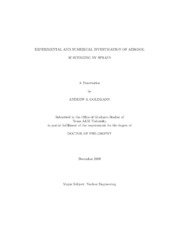| dc.contributor.advisor | Hassan, Yassin A. | |
| dc.creator | Goldmann, Andrew S. | |
| dc.date.accessioned | 2011-02-22T22:24:11Z | |
| dc.date.accessioned | 2011-02-22T23:47:53Z | |
| dc.date.available | 2011-02-22T22:24:11Z | |
| dc.date.available | 2011-02-22T23:47:53Z | |
| dc.date.created | 2009-12 | |
| dc.date.issued | 2011-02-22 | |
| dc.date.submitted | December 2009 | |
| dc.identifier.uri | https://hdl.handle.net/1969.1/ETD-TAMU-2009-12-7563 | |
| dc.description.abstract | In the event of a hypothetical nuclear reactor accident, the combination of plant
design, operator training, and safety procedures result in low level risks to the general
public; however, an additional offsite consequence mitigation system has the poten-
tial to substantially decrease the amount of radioactive material that could reach a
population zone in a postulated accident scenario. An experimental and numerical
investigation of airborne particulate scavenging by water sprays was conducted as
part of a consequence mitigation study. Previous researchers have experimentally
studied the removal of aerosols by sprays, but only in a confined region. The ex-
periment conducted in this research used an expansive region where sprays could
significantly affect the flow fields in the spray region.
Experimentation showed an expected trend of higher particle collection efficien-
cies with increased residency time within the spray region, with the highest average
overall collection efficiency found to be 70.6+/-3.2% at an air flow rate of 0.53 m/s and
a water flow rate of 0.84 gpm. This general trend is expected because a longer resi-
dency time leads to an increased probability of particle-drop interaction. Collection
efficiencies were also found to increase with increased particle number density. The
numerical investigation was done using a deterministic method and a Monte Carlo
method. Each model shows promise based on theoretical limitations of drop size for
the experimental conditions. The theory demonstrates that particle-drop relative velocity as well as the sizes significantly affect collection efficiency. An alternative
study was conducted to determine the collection efficiency of non-wettable particles
since the dust used in the experiment is hydrophobic. Computational Fluid Dynam-
ics (CFD) models were also performed to determine the flow fields that developed
within the experiment spray region and substantiate differences in the experimental
and numerical models. | en |
| dc.format.mimetype | application/pdf | |
| dc.language.iso | en_US | |
| dc.subject | Aerosol Scavenging | en |
| dc.subject | Impaction | en |
| dc.subject | Non-Ideal Collection | en |
| dc.title | Experimental and Numerical Investigation of Aerosol Scavenging by Sprays | en |
| dc.type | Book | en |
| dc.type | Thesis | en |
| thesis.degree.department | Nuclear Engineering | en |
| thesis.degree.discipline | Nuclear Engineering | en |
| thesis.degree.grantor | Texas A&M University | en |
| thesis.degree.name | Doctor of Philosophy | en |
| thesis.degree.level | Doctoral | en |
| dc.contributor.committeeMember | Marlow, William H. | |
| dc.contributor.committeeMember | Vierow, Karen | |
| dc.contributor.committeeMember | Banerjee, Debjyoti | |
| dc.type.genre | Electronic Dissertation | en |
| dc.type.material | text | en |


